COVID-19 and Healthy Buildings + Pandemic Reduces Rhino Poaching
Published: June 17, 2020
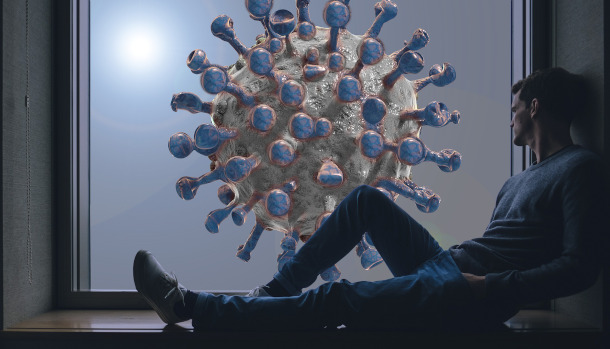
Opening a window can help reduce the transmission of coronavirus indoors. (Photo: Gerd Altmann, Pixabay)
(stream/download) as an MP3 file
The pandemic continues to spread, with over 7 million confirmed cases of COVID-19 worldwide by June 12, and research has shown that much of this spread has happened indoors. What we can do in our own homes, buildings, and even cars to reduce the risk of transmitting the virus.
Also, more than 80 percent of the world's African rhino population lives in South Africa, making the country the epicenter of the rhino poaching world. Though the number of rhinos killed has steadily decreased since 2014, the coronavirus pandemic has brought a major drop in poaching.
CURWOOD: Hi, I’m Steve Curwood and today on the Living on Earth Podcast we’ll have a conversation about how to stay healthier in buildings in the time of Coronavirus.
Also, an unexpected way in which the pandemic is helping rhinos.
But first, your support helps make it possible to bring you this podcast, so please contribute what you can.
Five dollars or more makes a difference.
You can donate right now at LOE.org and thanks!
[THEME]
CURWOOD: Love your neighbor, but stay away and wear a mask, especially indoors. That’s the ethos of the COVID-19 pandemic that has already taken more than one hundred thousand lives in the US and sickened four million people around the world. Direct sunlight, fresh air and heat can quickly disperse contagious virus particles in the air outdoors but inside those particles can linger in the air for three or more hours. Fortunately, there are ways to be safer indoors, according to Joe Allen who teaches at the T H Chan School of Public Health and directs the Healthy Buildings Program at Harvard University. I asked Professor Allen to explain how buildings can be set up to reduce the spread of the virus.
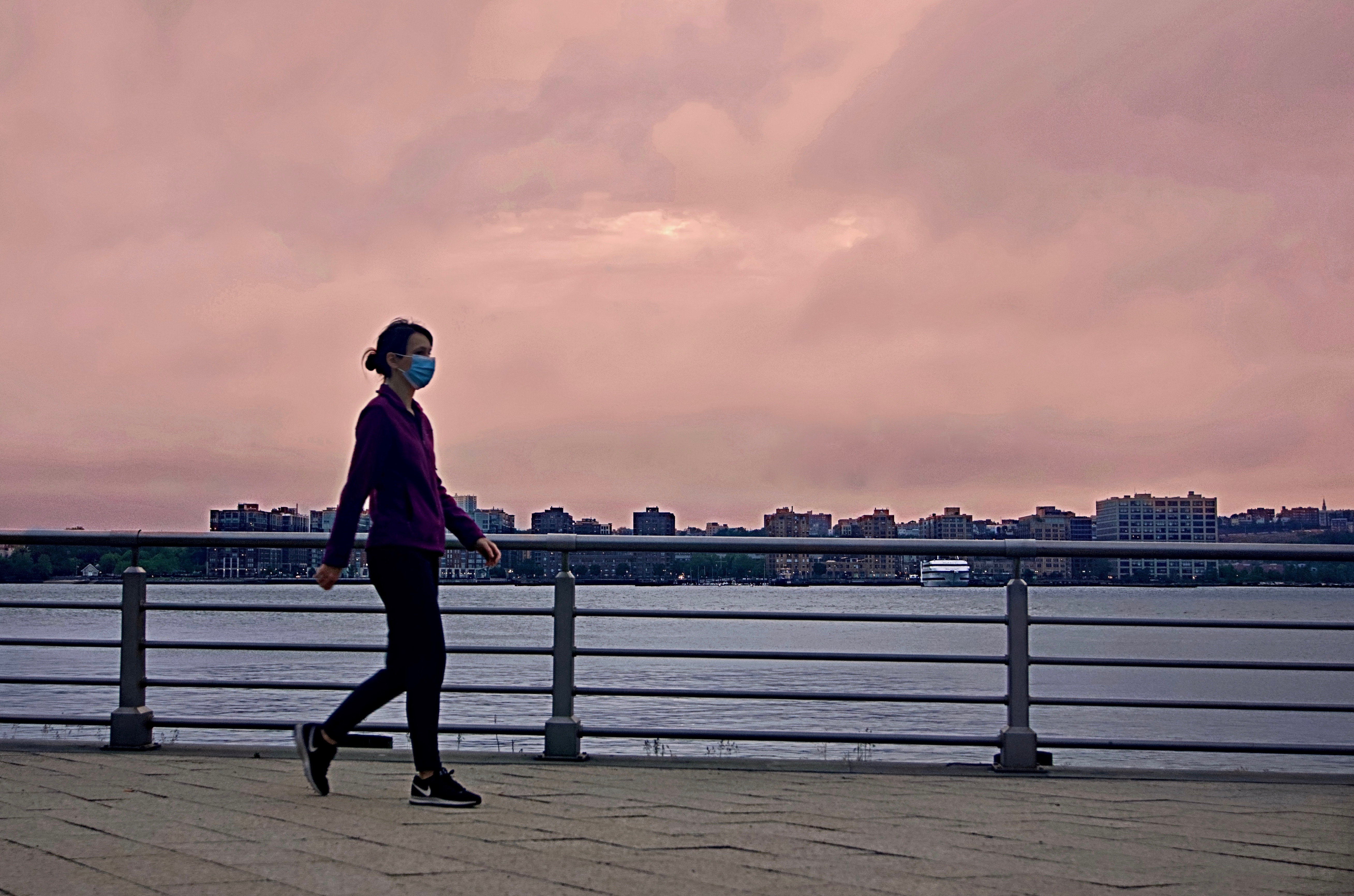
A walker on the Chelsea Piers in Manhattan. Joe Allen advocates for public parks to remain open as long as social distancing is practiced. (Photo: Andreas Komodromos, Flickr CC BY-NC 2.0)
ALLEN: Well, you know, so buildings play a central role and we've long known historically that buildings that perform poorly can aid in the transmission of disease. We know this from thinking about measles in schools, and a classic example: one school girl goes into a building. Dozens get infected despite being vaccinated because of a poorly performing HVAC or mechanical air conditioning system. We see examples from the first SARS outbreak of one person going into a hotel, 16 other people become infected seeding a global outbreak, and even right from this SARS-CoV-2, this COVID-19 disease, we see examples from the cruise ships, the Biogen conference, the Kirkland senior homes and on and on all showing that the building plays a key role in transmitting that disease. The good thing is that we also know this means that the buildings are performing well that they can act as a first line of defense.
CURWOOD: Tell us everybody is really excited to hear from you just how healthy buildings can be brought into this fight against the coronavirus which, as we speak today, there's no vaccination, there's really kind of a bit of treatment for it?
ALLEN: Yeah. So you know, when we think about buildings, we first have to think of how we're exposed to this virus. So quick little primer right three modes of transmission, large droplet transmission foamite, which is inanimate surfaces that act as a source of transference and airborne transmission. And healthy buildings can act on all three of these. So let's start with that airborne one, and how you would do that. So if you bring in a little more fresh outdoor air, you dilute airborne contaminants indoors, the real basics here. Second, if you're recirculating that air and many buildings do recirculate air, you want to enhance the level of filtration so that if there's any virus in the air, it's captured or impacted out on a high efficiency filter. Then in terms of other strategies, you want to enhance cleaning and disinfection, which addresses foamite transmission. And then of course, we have to do all these things that you and I and everybody else should be doing, maintaining physical distancing, hand washing, covering our coughs, staying home and sick. Those are not necessarily building controls, but we can't just say the building has the sole responsibility. We all have a role to play here. And so it's getting back to the basics of buildings and public health one on one right now, in terms of how we combat this disease and the indoor environment we know is key to the spread of this virus, but it can be leveraged in the fight against it.
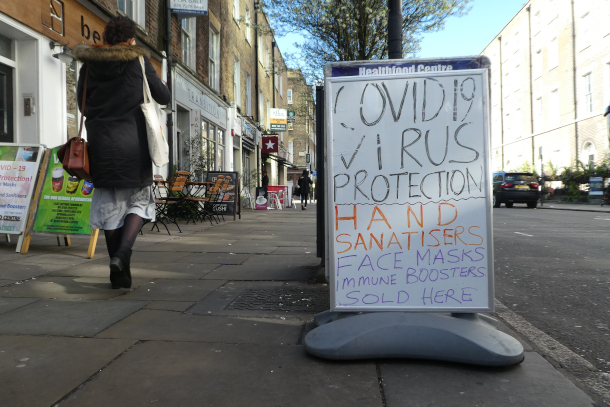
As Joe Allen describes, COVID-19 spreads through large droplets, contaminated surfaces, and aerosol transmission. (Photo: Duncan C, Flickr CC By-NC 2.0)
CURWOOD: So Joe, one of the things I think I just heard you say is that if you open the windows in a building, that could help reduce the spread of this virus, how does into a transmission of the virus compared to being say completely outside?
ALLEN: Well, look, right. If you can be outside, you have unlimited dilution, so that's a good thing, right? I Marc Lipsitch and I at the Harvard School of Public Health with Ned Friedman, the director of the Arnold Arboretum at Harvard, have written a piece urging governments to keep parks open. They can be managed safely, the exposure risk is lower, if people behave as they should and take the proper appropriate precautions. But you're exactly right. You know, it's as simple as getting back to the basics, opening your windows a little bit at home, in your car if you're with other people, we did some modeling with Professor Rich Corsi and Jack Spengler that showed if you just crack the window three inches, you can significantly reduce the amount of virus in the air if someone is sick and shedding virus through coughing, sneezing, or just breathing. So it's the real basics here, bring in some more outdoor air.
CURWOOD: And remind us, Joe, of why the amount of virus matters in this situation. Why obvious if you roll the window down, there's still going to be some virus. Why does that make a difference?
ALLEN: Yeah, I like that you asked that because this is you know, my official professor title is a professor of exposure assessment science. And this is the basics of exposure science. You have to think about exposure at three variables really one is the intensity of the exposure. So how much are you breathing and exposed to, second is frequency and the third is duration. So let's make this really understandable. If you and I were together and I was infectious and I cough and we're close, well, that intensity is going to be high, just because we're close, it will be less intense if you're on the other side of the room. The frequency matters too, because if I cough once, that's a certain amount of viral shedding. If I cough every 10 seconds, that's a lot more, so the frequency is intense. And last is that duration factor. If we had a one minute conversation where I coughed, that's very different than if you and I sat together for a couple hours, and I'm frequently coughing and you're close by. So it's a combination of intensity, frequency and exposure. And if you can reduce all of those, you reduce your exposure and therefore ultimately reduce your risk.
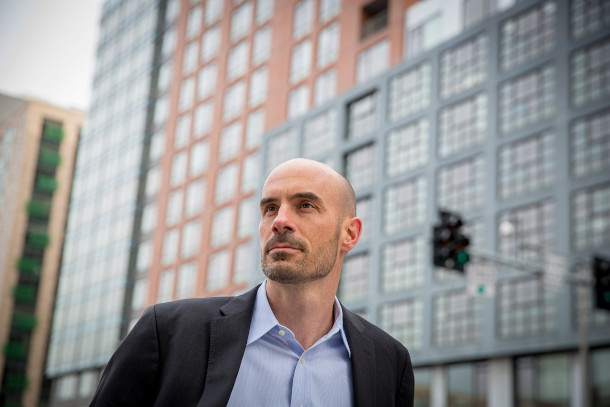
Joe Allen directs Harvard’s Healthy Buildings program. (Photo: Courtesy of Joe Allen)
CURWOOD: So there's a lot of chatter, some people are saying, if people want to get together, it's better to meet outside. For example, if I have my daughter and her husband and their new baby, come and visit me be outside at the picnic table, there's a bit of a breeze. I'm going to be better off there?
ALLEN: Yeah, definitely. You know, we started out by saying social distancing, but I don't like the term. Really, it's physical distancing, right? We still want to connect we still need to connect with people and we can do this outside my family did this last weekend where everyone met in the backyard, each family had their own little corner on the deck. Maintain physical distancing, you know couldn't do the hugs are handshakes but that's okay. You know, it's just great to see people in person and you can do it outside. You know the family stayed in a pod or a cluster and we just maintain a minimum of six foot distance between people.
CURWOOD: Joe Allen is an Assistant professor at the T H Chan School of Public Health and directs the Healthy Buildings Program at Harvard University.
[MUSIC]
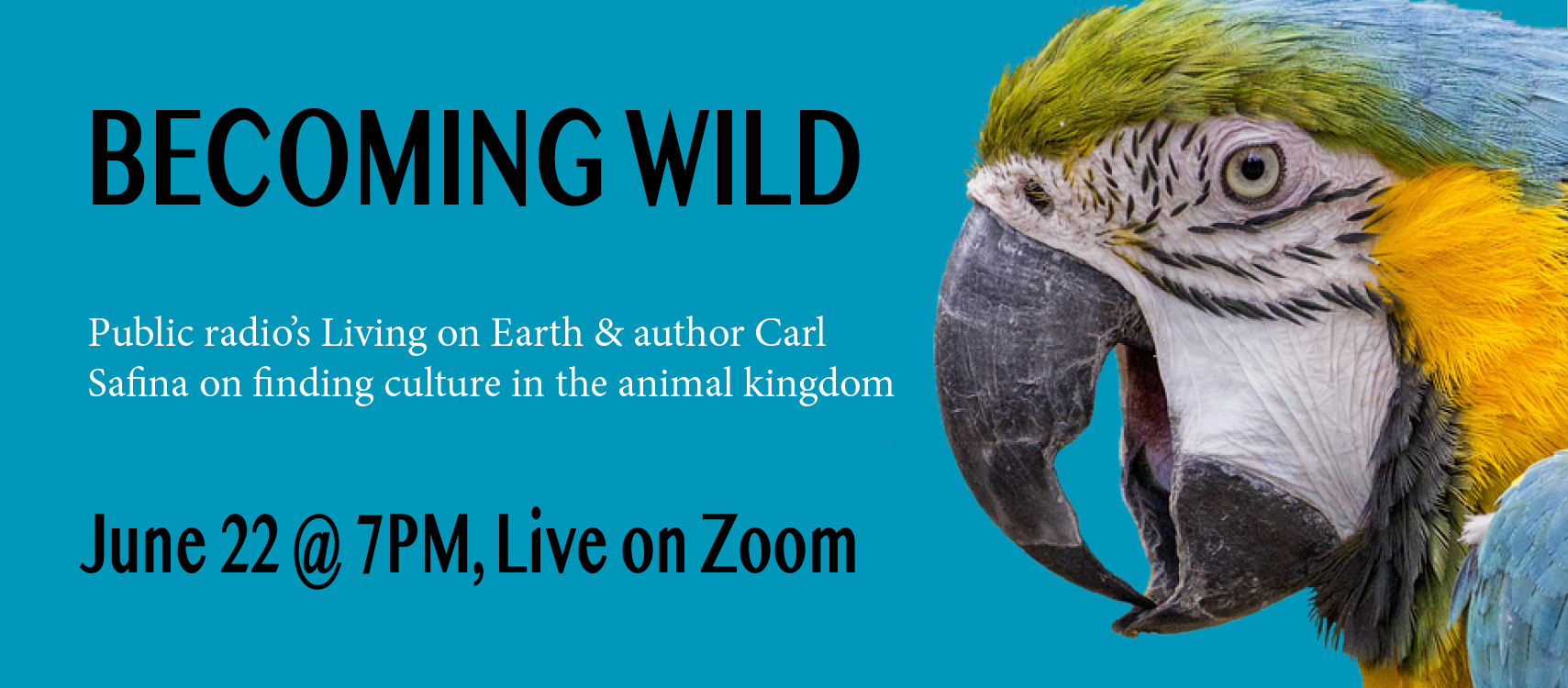
CURWOOD: Please join us for the next live Living on Earth Good Reads on Earth event. We will be speaking with award-winning biologist and author Carl Safina about his latest book Becoming Wild: How Animal Cultures Raise Families, Create Beauty, and Achieve Peace. It's a provocative exploration of the complex communities that exist among sperm whales, scarlet macaws, and chimpanzees. You can be part of the conversation online via Zoom or Facebook, and please ask questions, if you like. That’s Monday, June 22nd at 7 PM Eastern. Details are available at loe.org. Just click on the events tab at the top of the page.
CURWOOD: Just ahead, when it comes to rhino poaching in South Africa the pandemic is playing a surprising role. But first this note on emerging science from Don Lyman.
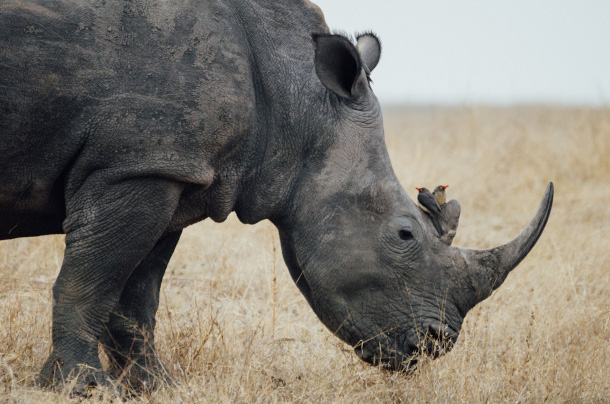
Two oxpeckers perch atop the head of a Black Rhino. (Photo: Wendy, Flickr, CC BY-NC-ND 2.0)
[SCIENCE NOTE THEME]
LYMAN: Red-billed oxpeckers are a species of bird that lives in the African bush. These eight-inch-long brown birds with distinctive red bills and yellow-ringed red eyes can often be seen riding on the backs of large mammals, including giraffes, Cape buffalo, and endangered rhinos, where they feed on ticks and other parasites on the animals’ hides.
But new research reveals that the oxpeckers’ symbiotic services extend beyond parasite removal. Rhinos have very poor vision but oxpeckers can see exceptionally well and issue a shrill alarm call which can warn the rhinos of potential danger.
Researchers in the study approached 11 black rhinos by foot on the open plain on 86 occasions. They found that rhinos with a red-billed oxpecker on their backs were much better at detecting the researchers’ presence than those without an oxpecker.
Rhinos without oxpeckers on their backs were able to detect the scientists approaching only 23 percent of the time, but rhinos with oxpeckers detected the scientists 100 percent of the time. The researchers also reported that rhinos listening to an oxpecker’s alarm call picked up on the approaching scientists from 61 meters away, more than twice as far as when there were no oxpeckers with the rhinos.
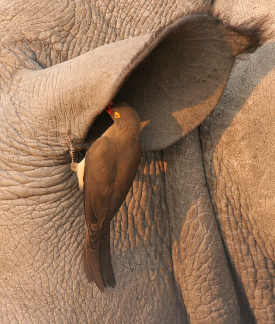
A red-billed oxpecker near a rhino’s ear. (Photo: Brian Scott, Flickr, CC BY-NC-ND 2.0)
All the rhinos they observed responded to the oxpeckers’ alarm calls by becoming more vigilant — they stood up if they had been resting — and turned to face downwind. Then the rhinos either ran away or walked downwind to investigate the potential danger.
Black rhinos where at one time the most numerous species of rhino in the world, but poaching for traditional Chinese medicine has resulted in black rhinos becoming critically endangered. Only an estimated 5,500 black rhinos remain in the wild.
Red-billed oxpeckers numbers have declined as well because of pesticides used to kill parasites on domestic cattle, which the oxpeckers also feed off of.
The researchers said that oxpeckers may help rhinos evade poachers, but one wildlife biologist cautioned that a lot of poaching takes place at night when the oxpeckers would be sleeping and not able to alert the rhinos to approaching danger.
That’s this week’s note on emerging science. I’m Don Lyman.
CURWOOD: More than 80 percent of the African rhinos remaining in the world are in South Africa, making it the hotspot for rhino poaching. The numbers of rhinos killed for their horns has been slowly declining over recent years but the COVID-19 pandemic, and a strict lockdown by the South African government, has quelled rhino poaching even more. Jo Shaw, Senior Manager and African Rhino Lead for the World Wildlife Fund spoke with Living on Earth’s Bobby Bascomb.
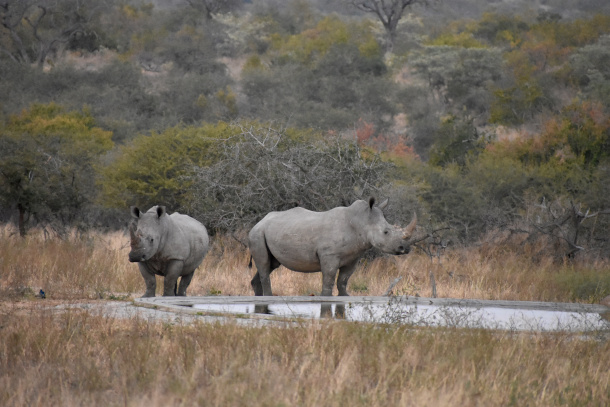
Two white rhinos in Kruger National Park. (Photo: Jen, Flickr, CC BY 2.0)
BASCOMB: Jo, what were the statistics and the numbers of rhinos poached in South Africa before and after the Coronavirus began?
SHAW: So, Bobby, as you know, rhino poaching has been a major problem in South Africa for the last decade, probably peaking around 2014 when we were losing around three rhinos a day. There has been quite a gradual decline since then, to a total of 594 animals killed in 2019. But since the COVID pandemic and the major lockdown that's been put in place in South Africa, we've seen a dramatic decline in the rates of Rhino poaching since lockdown commenced. The Minister of the Environment, Forestry and Fisheries stated that April 2020, in Kruger National Park, which is home to the majority of rhinos in South Africa, only five rhinos were poached during April 2020 compared to 46, a year previously in April 2019.
BASCOMB: And why do you think that is?
SHAW: It's something we're digging into to try and understand better. I mean, I think there are probably, as always, with this complex problem, a number of different explanations at different layers. So, all of the parks have been closed. Gates are shut, lodges are shut. There's nobody coming into the parks, but the rangers themselves are essential services, so they're able to continue to do their jobs. And South Africa itself has had a very restrictive lockdown process. So, people have been confined to their homes, only more recently able to get out once a day to exercise. On top of that movement between provinces has been restricted, and even international flights have been closed. So there's very little opportunity for people or rhino horn products to be trafficked.
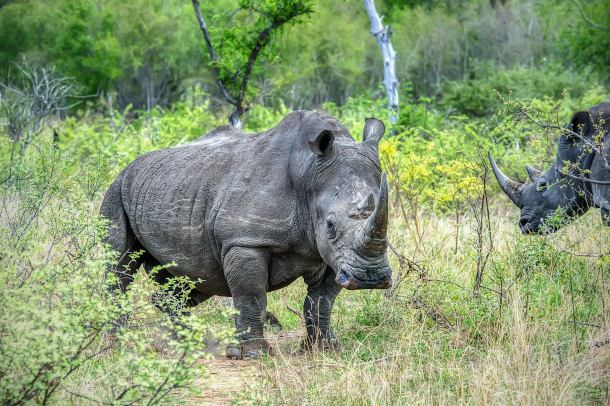
It’s speculated that the decline in rhino poaching numbers are impacted by the shutdown of international travel, making it harder to traffic the rhino horn to buyers. (Photo: Brook Ward, Flickr, CC BY-NC 2.0)
BASCOMB: So do you attribute then a lot of the drop in rhino poaching to a lack of demand? I mean, if they can't get the product out of the country to markets in Asia, I mean, what point is there? Is that sort of what you're thinking?
SHAW: Yes, it does seem as though there's been some breakage in the chain at some point. The Minister of the Environment released a statement in which she announced this very dramatic decline, and even suggested that perhaps the fact that in some of the larger parks like Kruger National Park, people had been using tourist entry gates to access the parks and to be able to go in and drop poachers off to kill rhinos. And perhaps the closure of these gates and the dramatic decrease in access into the parks had also just prevented people from being able to get into the park to poach rhinos.
BASCOMB: But of course poachers, by definition are already breaking the law. So I would think, you know, that they wouldn't worry so much about breaking the lockdown laws to continue the slaughter.
SHAW: Yes, there does seem to be this logistical blockage that somewhere down the line has made the system much harder to operate. The challenge now is to try and understand what is that weak link in the chain that's made such a big difference? And is there a way we can come up with to try and keep these numbers so low, even as lockdown restrictions are lifted. I think it's worth flagging that there is, of course a negative aspects to this closure of Parks and Tourism activities. In South Africa, tourism revenue is responsible for most of the operating budget of our parks in terms of protection, animal monitoring, animal management. And so without the income coming from tourists paying gate fees or paying for accommodation or game drives, our parks are seeing a really major decline, a huge loss of revenue that would normally be used to pay for the operating costs going forward. So I think this is something to be very concerned about in parallel.
BASCOMB: So, the trick then is to find a way to balance that. I mean, it's great for the poaching numbers. But obviously you need the revenue still, to keep the parks open in the future.
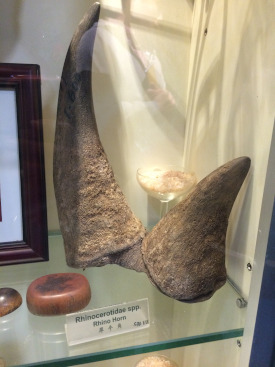
Rhino horn, seized by the Hong Kong government, on display in Hong Kong’s Agriculture, Fisheries and Conservation Department Visitor Center. (Photo: US Government Accountability Office, Public Domain)
SHAW: Yes, absolutely. Obviously, it's not the right solution for anybody for lots of reasons to maintain this very restrictive lockdown for a long period. I think what's going to be the challenge for all of us is to try and identify what are these narrow links in the chain where we've been able to stop the movement of rhino horn, and see if there's a way that we can replicate that without continuing to enforce a major lockdown.
BASCOMB: You know, it's easy to imagine the relationship between the pandemic and poaching going a totally different direction, you know, with no tourists around to deter the poachers. They could become more emboldened. And, of course, people can get really desperate when they suddenly can't go to work and support their families. How surprised were you, if at all, by the way this turned out?
SHAW: Yeah, I mean, this is definitely an unintended consequence of lockdown, obviously that we're, we're grateful for and as I say, trying to work on ways to continue post-lockdown. I think one of the other interesting pieces of information in the minister's recent release is the fact that bushmeat poaching, so snaring for meat within the parks also hasn't increased in the way that one might expect as people's livelihoods become less secure and jobs are lost. And in parallel with this challenge I've described going forward about the loss of operating budgets for parks. We need to be thinking about the people who live around them and the possible impacts of the loss of jobs due to the closure of nature based tourism businesses, and try and look for ways not just to diversify funding sources and funding income for parks, but diversify opportunities and make sure food security plans are in place for people who live in these areas?
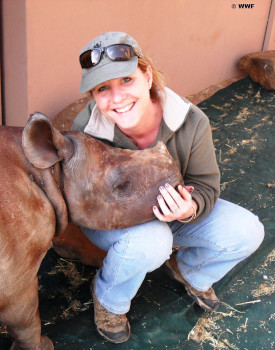
Jo Shaw is the African Rhino Lead for the World Wildlife Fund. (Photo: Courtesy of World Wildlife Fund)
BASCOMB: Well, that's the thing. It's not like, you know, the pandemic, let's say it's over tomorrow and things go back to normal immediately the next day. I mean, this is going to persist for a long, long time, the knockoff effects, the economic effects of the pandemic.
SHAW: Yes, I think the broader economic effects will be challenging for rhinos, and for conservation more broadly, for really quite a long time to come. It could take months, if not years for tourism to reach the levels that it was operating at previously. And without that money, we need to find other ways to fund our protected areas in Africa, but, but also in Asia, in the States, around the world. I think it's a big challenge for everybody to be considering.
CURWOOD: That’s Jo Shaw, Senior Manager and African Rhino Lead for the World Wildlife Fund speaking with Living on Earth’s Bobby Bascomb.
[MUSIC]
CURWOOD: Living on Earth is produced by the World Media Foundation.
Our crew includes Naomi Arenberg, Paloma Beltran, Bobby Bascomb, Thurston Briscoe, Jenni Doering, Jay Feinstein, Anne Flaherty, Don Lyman, Isaac Merson, Aynsley O’Neill, Jake Rego, Kori Suzuki, and Jolanda Omari.
Tom Tiger engineered our show.
Alison Lirish Dean composed our themes.
You can hear us anytime at L-O-E dot org, Apple Podcasts and Google Podcasts- and like us, please, on our Facebook page - Living on Earth.
we tweet from @livingonearth. And find us on Instagram at livingonearthradio.
I’m Steve Curwood
Thanks for listening!
ANNOUNCER: Support for Living on Earth comes from Sailors for the Sea and Oceana. Helping boaters race clean, sail green and protect the seas they love. More information at sailors for the sea dot org.
ANNOUNCER 2: PRX.
Links
The Washington Post | “Keep Parks Open. The Benefits of Fresh Air Outweigh the Risks of Infection”
Joe Allen’s latest book, Healthy Buildings: How Indoor Spaces Drive Performance and Productivity
Read the study in Current Biology: Oxpeckers Help Rhinos Evade Humans
National Geographic | “Bird Alarm Calls Help Rhinos Avoid People—And Possibly Poachers”
Living on Earth wants to hear from you!
Living on Earth
62 Calef Highway, Suite 212
Lee, NH 03861
Telephone: 617-287-4121
E-mail: comments@loe.org
Newsletter [Click here]
Donate to Living on Earth!
Living on Earth is an independent media program and relies entirely on contributions from listeners and institutions supporting public service. Please donate now to preserve an independent environmental voice.
NewsletterLiving on Earth offers a weekly delivery of the show's rundown to your mailbox. Sign up for our newsletter today!
 Sailors For The Sea: Be the change you want to sea.
Sailors For The Sea: Be the change you want to sea.
 The Grantham Foundation for the Protection of the Environment: Committed to protecting and improving the health of the global environment.
The Grantham Foundation for the Protection of the Environment: Committed to protecting and improving the health of the global environment.
 Contribute to Living on Earth and receive, as our gift to you, an archival print of one of Mark Seth Lender's extraordinary wildlife photographs. Follow the link to see Mark's current collection of photographs.
Contribute to Living on Earth and receive, as our gift to you, an archival print of one of Mark Seth Lender's extraordinary wildlife photographs. Follow the link to see Mark's current collection of photographs.
 Buy a signed copy of Mark Seth Lender's book Smeagull the Seagull & support Living on Earth
Buy a signed copy of Mark Seth Lender's book Smeagull the Seagull & support Living on Earth

